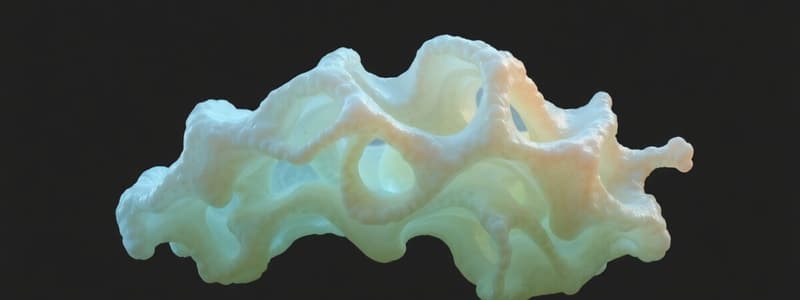Podcast
Questions and Answers
What type of cartilage is known for being the most flexible?
What type of cartilage is known for being the most flexible?
- Elastic (correct)
- Dense
- Hyaline
- Fibrous
Which type of cartilage is primarily responsible for structural integrity?
Which type of cartilage is primarily responsible for structural integrity?
- Hyaline (correct)
- Elastic
- Fibrous
- Reticular
Where can fibrous cartilage commonly be found in the human body?
Where can fibrous cartilage commonly be found in the human body?
- In the ear
- In the epiglottis
- In the nose
- In intervertebral disks (correct)
Which statement about hyaline cartilage is true?
Which statement about hyaline cartilage is true?
Which of the following characteristics is true for elastic cartilage?
Which of the following characteristics is true for elastic cartilage?
Which type of cartilage is not easily repaired following injury?
Which type of cartilage is not easily repaired following injury?
What type of cell is essential for bone formation?
What type of cell is essential for bone formation?
Approximately how many red blood cells are produced in the bone marrow?
Approximately how many red blood cells are produced in the bone marrow?
Which of the following is NOT a function of bones?
Which of the following is NOT a function of bones?
What type of cartilage is found at the temporomandibular joint (TMJ)?
What type of cartilage is found at the temporomandibular joint (TMJ)?
What is the primary purpose of knowing about bones?
What is the primary purpose of knowing about bones?
Which of these bones functions in mineral storage?
Which of these bones functions in mineral storage?
Erythropoiesis refers to what process in the bone marrow?
Erythropoiesis refers to what process in the bone marrow?
Which of the following is a characteristic of fibrous cartilage?
Which of the following is a characteristic of fibrous cartilage?
What structure do osteocytes primarily reside in?
What structure do osteocytes primarily reside in?
Which function of bones contributes to maintaining body balance?
Which function of bones contributes to maintaining body balance?
Flashcards are hidden until you start studying
Study Notes
Cartilage Overview
- Cartilage is a type of connective tissue vital for structural integrity and flexibility in the body.
- Three primary types of cartilage: Hyaline, Fibrous, and Elastic.
Hyaline Cartilage
- Comprises small groups of chondrocytes and is responsible for maintaining structural integrity.
- The matrix is smooth, solid, and provides a glossy, bluish-white appearance.
- Has a poor healing ability due to limited blood supply following injury.
Fibrous Cartilage
- Located in pivotal joints, including the knee and temporomandibular joint (TMJ).
- Characterized as dense, tough, and slightly flexible, making it suitable for withstanding pressure.
- Found in intervertebral disks, providing cushioning for the spinal column.
Elastic Cartilage
- The most flexible and least common type of cartilage.
- Comprising structures like the ear and epiglottis, it allows for resilience and shape retention.
- Also found in parts of the larynx and trachea, contributing to airway structure.
Osteocytes and Osteoblasts
- Osteocytes refer to mature bone cells, not infections.
- Osteoblasts are specialized cells essential for bone formation and mineralization.
Red Blood Cell Production
- Approximately 2 million red blood cells are produced in the bone marrow daily.
- This process is known as erythropoiesis, crucial for maintaining blood oxygen levels.
Importance of Bones
- Knowledge of bones aids in diagnostics within medicine.
- Bones serve multiple functions: support, protection, movement, mineral storage, blood cell production, energy storage, and aiding in balance.
Cartilage at the TMJ
- Fibrous cartilage is found at the TMJ due to its shock-absorbing properties.
- Provides stability by maintaining the connection between the mandible and temporal bone.
Types of Bones
- Long bones include femur and humerus; short bones are carpals and tarsals; flat bones comprise the sternum, ribs, and skull; irregular bones encompass facial bones such as the mandible and maxilla; the patella is classified as a sesamoid bone.
Ossification Process
- Ossification is the critical process of bone formation, essential for skeletal development and growth.
- Intramembranous ossification involves the direct development of bone from connective tissue, as seen in the skull and clavicles.
- Endochondral ossification occurs when bone replaces a cartilage model, as in the formation of long bones like the femur and humerus.
Replacement of Cartilage by Bone
- The process of cartilage replacement by bone involves the coordinated action of osteoblasts and osteoclasts.
Studying That Suits You
Use AI to generate personalized quizzes and flashcards to suit your learning preferences.



